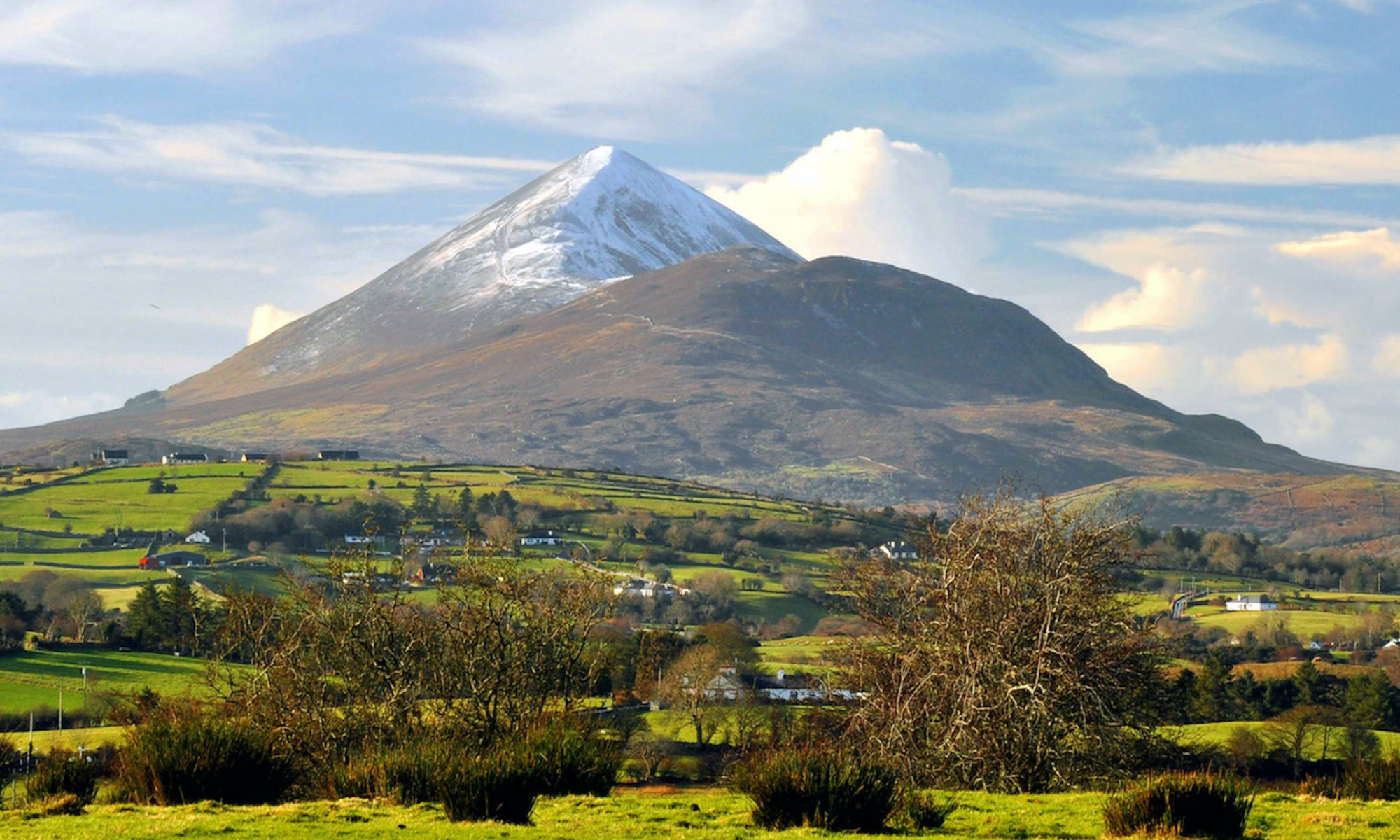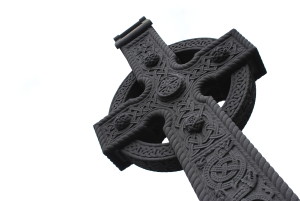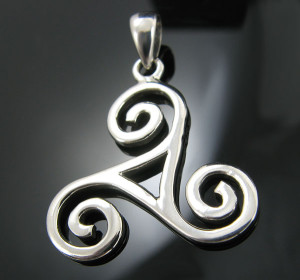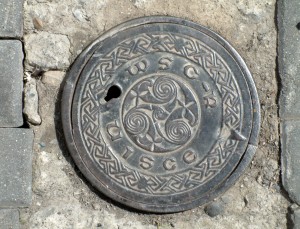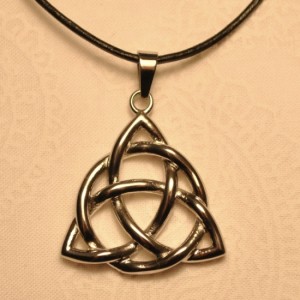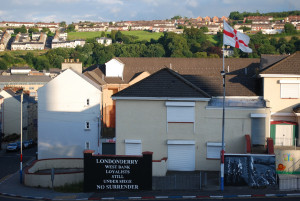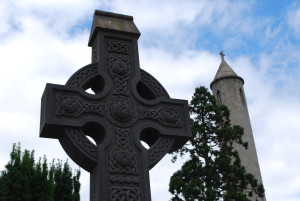Celtic Symbols and the Imagined Celtic Essence
Celtic symbols are central to what we now consider and imagine as “Celtic culture.” Many of them have stood the test of time, having originated hundreds of years ago but still continuing to have relevance and meaning in modern times. A few of the most famous Celtic symbols are the claddagh ring, the Celtic cross, the triskele, and the triquetra.
Basic History of Symbols
The Claddagh Ring
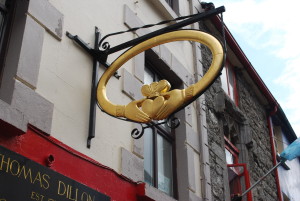
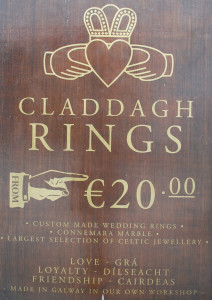 The claddagh ring is an iconic symbol of modern Celtic jewelery and was possibly invented as early as the seventeenth century, but was in circulation by the nineteenth. The word “claddagh” is the name for a town near the city of Galway, where a man named Robert Joyce lived with his wife before getting kidnapped by pirates and sold into slavery. The legend follows that he was forced to work in a goldsmiths shop, and that he created the first claddagh ring there. The hands represent friendship, the heart represents love, and the crown represents loyalty.
The claddagh ring is an iconic symbol of modern Celtic jewelery and was possibly invented as early as the seventeenth century, but was in circulation by the nineteenth. The word “claddagh” is the name for a town near the city of Galway, where a man named Robert Joyce lived with his wife before getting kidnapped by pirates and sold into slavery. The legend follows that he was forced to work in a goldsmiths shop, and that he created the first claddagh ring there. The hands represent friendship, the heart represents love, and the crown represents loyalty.
The above song suggests that the legend of Robert Joyce and the claddagh ring is still meaningful to many despite the passage of time.
A romantic tradition suggests that the direction of the ring on the owner’s finger is indicative of whether or not they are in a relationship. According to O’Dalaigh Jewellers in Clifden, the legend still rings true and meaningful to many ears, and the love story remains relevant through the modern day application of using the ring to symbolize the status of one’s personal relationship.
The Celtic Cross
The cross is a very significant symbol originating from the biblical story of Jesus. The Celtic Cross in particular dates back to the early Middle Ages, or the eighth to tenth century. According to jewelers at Thomas Dillon’s Claddagh Gold store in Galway, the cross is still significant today because “death and the afterlife were extremely important to the ancient Irish celts.”
At the 1853 Irish Industrial Exhibition in Dublin, exhibition chief financial officer T.D. Jones commented on the displays of crosses in the Antiquities Hall, claiming that they were intricate monuments indicative of his Celtic ancestors’ “devoted piety” and reverence for the religion of Christianity. Maggie M. Williams, author of the book Icons of Irishness, looks at this sentiment critically and ultimately concludes that his “elision of pagan Celts and Christian medievals is symptomatic of the contemporary impulse to fuse the two historical moments into a single, overarching cultural trait” (72).
The Triskele
According to O’Dalaigh Jewellers in Clifden, the triskele symbol, also known as the “wheel of life,” has been found on ancient carvings throughout Europe; as you can see from the picture above, it is now commonly found on manholes throughout Galway. The Celts felt that groups of threes were significant and meaningful in nature: earth, water and sky; body, mind and spirit; birth, death and rebirth; and past, present and future.
In Ireland, archaeological excavations have revealed that ancient people there often emphasized curvilinear designs and spirals. In Icons of Irishness, Williams states that “their predilection for organic forms and elaborately swirling patterns later fused with Christian iconographies in Ireland” (9).
The Triquetra
Also called the Trinity Knot, the triquetra is believed to predate the Cross by hundreds of years. The continuous knotwork symbolizes the Celts’ belief in the afterlife.
According to Helen Chantler, a modern day Irish jeweler, the triquetra represents “the maiden, mother and crone; the earth, heavens and the underworld; the past, present and future; and the body, mind and spirit.” She chooses not to relate the knot to the Holy Trinity, thus disassociating it from what many consider to be its primary symbolic significance (Williams, 64).
O’Dalaigh Jewellers also recognizes the symbol’s significance outside of Christianity, but to them, the symbol represents the Father, Son and the Holy Spirit above all other things. The difference between these two mindsets in the jewelery industry is just one example of how various parties can often appropriate symbols for their own means.
The Appropriation of Symbols
The picture above was taken in Derry, Northern Ireland. Upon visiting, I saw that on either side of the giant walls dividing the city, flags were displayed in juxtaposition to signs as a constant reminder of the city’s violent, divisive history. It became quickly apparent that those flags were more than just flags, and that the symbols they embodied still had a very deep, culturally relevant meaning.
In the article “Symbols: Sites of Creation and Contest in Northern Ireland,” symbols are described as images that “provide the material through which communities, groups, nations and states attempt to ‘imagine’ themselves…ethic, national and cultural identity is in a constant state of being constructed and reconstructed in an instrumental, pragmatic way to achieve group allegiance and solidarity” (Bryan, 127). In the case of Derry, this is still very true; signs and symbols were defaced in an emotional response to the violence of the past, but the city manages to maintain a peaceful appearance on the outermost surface. Disputes over symbols are common in Northern Ireland, and it makes everything significant; the “type of flag that flies over a building, the types of parades that march along particular streets, the statues and the paintings on the walls, the history of buildings, the crest or badge on a uniform…they symbolize the conflict.” (Bryan, 128). The article brings up the debate surrounding the question of whether or not to create a new set of identifying symbols, or defining appropriations of existing ones for the purpose of peace and unity.
This can often lead to problems. One debate was in regards to the display of Eastern lillies or shamrocks to mark the anniversary of the Easter Rising in Dublin. Sinn Fein representatives argued that such a tradition could be fair only if displays of poppies were accepted as a means of commemorating Armistice Day in November. Unionists, however, view that as a blatant display of terrorism. Ultimately, the problem was partially due to their search for “a symbol that represents nationalism but doesn’t represent terrorism,” a symbol that represents what they want to be rather than what they actually are (Bryan, 135). This impulse to use a unifying symbol or essence to rewrite the reality of Ireland was also prevalent in the Celtic Revival, in which writers like W.B. Yeats sought to redefine Ireland in hopes that Ireland would fit the mold after the fact.
The Individual vs. The Collective
Part of this appropriation is due to the Celtic symbol’s flexibility to symbolize aspects of the individual as well as the collective. In Icons of Irishness, Williams writes about Pat Fish, a tattoo artist and the self-proclaimed “Queen of the Celtic.” Having been born in California and adopted as a child, Fish eventually discovered that she was descended from “the famous tattooed warriors of Scotland,” her first connection to what she perceived as a grandiose collective culture. Fish was quoted as having said that she thinks “bagpipes are thrilling and knotwork mazes are kind of a visual prayer for complexity” (136). Her tattoos are subsequently both an expression of her perceived collective culture, embodied in “bagpipes” and “knotwork mazes,” and her personal interests as an individual.
In one of Fish’s designs, she combines the ringed Celtic cross with the claddagh symbol, which almost exclusively takes the form of a finger ring. Combining these symbols is an interesting move to make and one that is indicative of her stylistic choices as an artist. According to her, “the medieval Christian origins of ringed Irish crosses are virtually irrelevant…what matters is the form’s ability to signify a continuum of Celtic identity, an abstract sense of both independence and belonging that remains constant over time” (138). In this sense, tattoos and jewelery of Celtic symbols give the owner the power to both represent themselves and signify their connection to a distant Celtic past.
Icons of Irishness gives another prime example of this idea, when it describes Chris Scala’s tattoo: a classic cross with zombies and an archangel. The result is a symbol that is modified to the individual; it is “both individual and collective, public and private, and it touched both the Celtic and the medieval in innumerable ways” (140).
The Imagined Celtic Essence
A jeweler in Sligo told me that the vast majority of buyers that come into her shop are interested not just in buying a random item, but in the meanings that specifically pertain to the various symbols. An article titled “The Gift of Celtic Sight” comments on “the Celtic way of seeing,” and why that makes its culture “durable and appealing” even in modern times (Phillips, 569). It discusses four aspects of Celtic culture: the center, the journey, the complexity, and the weave. The center alludes to the focus and center of Celtic culture, namely God or the divine; the journey represents both the personal journey that starts from the center as well as the collective, cultural journey that we started as the human race. Using the symbol of a spiral to indicate meaning, the speaker evidences the Celtic interest in the complexity of life with a reference to the “whorls of illuminated, knotted letters” so prevalent in ancient Celtic art. The weave represents the connection of all of that complexity under one roof, the unity of what many of the symbols discussed above have always symbolized: the harmony of body, mind and spirit; the harmony of birth, death, and the afterlife (572). The article states that “from the Celtic perspective, the nature of the universe is to be interwoven, interconnected, and in relationship…Mary and the saints are daily companions who come calling in any croft or barn, and are received as intimates, along with the dead heroes of history who are conversed with as present friends” (575). Symbols have constant relevance in our everyday lives.
I believe this is significant in that it provides insight as to why so many people wish to connect with the Celtic past through their association with Celtic symbols, whether it take the form of jewelery, tattoos, or other means. These symbols were always meant to stand the test of time, and with modern day society’s obsession with commodification, their ability to represent both the individual and the collective is definitely a strong selling point.
However, Williams’ Icons of Irishness highlights the issue with the “Celtic essence,” imbued in so many of these symbols. Her view of the term “Celtic” as a “descriptor of a broader, stylistic phenomenon” rather than “a word that refers to a specific historical culture,” sheds light on why these symbols have the potential to become so removed from their origins and history, yet still be representative of Celtic culture (10). Her point about images is perhaps the most significant:
“Images offer the opportunity to collapse history in an immediate way that is virtually impossible for most texts or other forms of cultural production to achieve” (12).
The visual nature of symbols makes it easy for them to be appropriated, commodified, and used for both individual and collective means. In that sense, symbols are able to remain in a constant state of both timelessness and adaptation.
Works Consulted
Bryan, Dominic and McIntosh, Gillian. “Symbols: Sites of Creation and Contest in Northern Ireland.” The SAIS Review of International Affairs 25.2 (2005): 127-137. Web. 7 July 2015.
Phillips, Jennifer M. “The Gift of Celtic Sight.” Anglican Theological Review 80.4 (1997): 567-580. Web. 7 July 2015.
Williams, Maggie M. Icons of Irishness from the Middle Ages to the Modern World. Palgrave Macmillan, 2012. Kindle.
